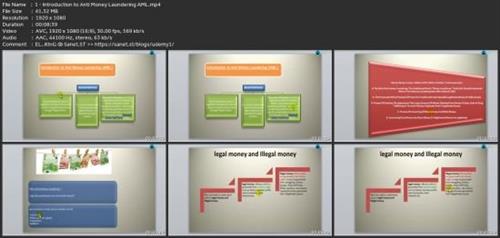- Thread Starter
- #1
Introduction To Anti-Money Laundering (Aml)

Master the essentials of Anti-Money Laundering (AML) to safeguard financial systems and ensure regulatory compliance.
What you'll learn
The foundational principles and importance of Anti-Money Laundering (AML) in protecting financial systems.
The different methods used for money laundering, including understanding the stages of the process-placement, layering, and integration.
The purpose and strategies behind money laundering, with real-world examples.
How to apply KYC (Know Your Customer) standards and regulations in financial systems to prevent money laundering.
The global role and functions of the FATF (Financial Action Task Force) in setting AML standards.
Key procedures in retail banking and financial institutions related to AML and KYC.
Requirements
Basic understanding of finance: A foundational knowledge of financial systems, banking, or related fields will be helpful but not mandatory.
Interest in compliance and regulations: This course is suitable for learners interested in understanding legal, financial, and regulatory frameworks.
Description
Section 1: IntroductionIn this section, students will gain a foundational understanding of Anti-Money Laundering (AML) practices. The introductory lecture provides an overview of AML, explaining its significance in combating illegal financial activities and protecting global financial systems from exploitation.Section 2: MethodsThis section delves deeper into the methods and mechanisms of money laundering. Students will learn about the purpose of money laundering, exploring the motives behind concealing illegally obtained funds. It will also cover the different ways in which money laundering can occur, providing real-world examples to enhance understanding. The stages of money laundering, including placement, layering, and integration, will be discussed in detail to help students recognize how illicit funds are cycled through financial systems.Section 3: ERP ExplanationThe final section covers the ERP (Enterprise Resource Planning) aspects related to AML practices, focusing on international standards and guidelines. Lectures will explore the functions of the FATF (Financial Action Task Force), the global watchdog for financial crimes. KYC (Know Your Customer) training will be introduced, emphasizing its importance in verifying customer identities and reducing risk in financial institutions. Topics like retail banking and KYC standards will help students understand how financial institutions implement AML protocols in day-to-day operations, particularly in customer onboarding and transaction monitoring.ConclusionBy the end of this course, students will have a thorough understanding of Anti-Money Laundering (AML) principles, methods, and regulatory frameworks. They will be equipped with the skills necessary to identify suspicious financial activities, ensuring compliance with global standards and contributing to the fight against financial crime.
Overview
Section 1: Introduction
Lecture 1 Introduction to Anti Money Laundering (AML)
Section 2: Methods
Lecture 2 Purpose Of Money Laundering
Lecture 3 Different Ways of Money laundering
Lecture 4 Stages of Money Laundering
Section 3: ERP Explanation
Lecture 5 Functions of FATF
Lecture 6 KYC Training
Lecture 7 Retail Banking
Lecture 8 KYC Standard
Finance professionals: Individuals working in banking, financial services, or accounting who want to enhance their understanding of Anti-Money Laundering (AML) practices.,Compliance officers: Those responsible for ensuring their organization follows legal and regulatory standards related to financial crimes.,Legal professionals: Lawyers or consultants specializing in financial crime, fraud, or regulatory compliance.,Students and graduates: Individuals pursuing careers in finance, banking, law, or related fields.,Business owners and managers: Entrepreneurs looking to protect their businesses from financial fraud and money laundering activities.,Anyone interested in financial crime prevention: Those curious about how AML practices work and how they affect global financial systems.

Say "Thank You"
rapidgator.net:
ddownload.com:

Last updated 10/2024
MP4 | Video: h264, 1920x1080 | Audio: AAC, 44.1 KHz
Language: English | Size: 426.43 MB | Duration: 0h 58m
MP4 | Video: h264, 1920x1080 | Audio: AAC, 44.1 KHz
Language: English | Size: 426.43 MB | Duration: 0h 58m
Master the essentials of Anti-Money Laundering (AML) to safeguard financial systems and ensure regulatory compliance.
What you'll learn
The foundational principles and importance of Anti-Money Laundering (AML) in protecting financial systems.
The different methods used for money laundering, including understanding the stages of the process-placement, layering, and integration.
The purpose and strategies behind money laundering, with real-world examples.
How to apply KYC (Know Your Customer) standards and regulations in financial systems to prevent money laundering.
The global role and functions of the FATF (Financial Action Task Force) in setting AML standards.
Key procedures in retail banking and financial institutions related to AML and KYC.
Requirements
Basic understanding of finance: A foundational knowledge of financial systems, banking, or related fields will be helpful but not mandatory.
Interest in compliance and regulations: This course is suitable for learners interested in understanding legal, financial, and regulatory frameworks.
Description
Section 1: IntroductionIn this section, students will gain a foundational understanding of Anti-Money Laundering (AML) practices. The introductory lecture provides an overview of AML, explaining its significance in combating illegal financial activities and protecting global financial systems from exploitation.Section 2: MethodsThis section delves deeper into the methods and mechanisms of money laundering. Students will learn about the purpose of money laundering, exploring the motives behind concealing illegally obtained funds. It will also cover the different ways in which money laundering can occur, providing real-world examples to enhance understanding. The stages of money laundering, including placement, layering, and integration, will be discussed in detail to help students recognize how illicit funds are cycled through financial systems.Section 3: ERP ExplanationThe final section covers the ERP (Enterprise Resource Planning) aspects related to AML practices, focusing on international standards and guidelines. Lectures will explore the functions of the FATF (Financial Action Task Force), the global watchdog for financial crimes. KYC (Know Your Customer) training will be introduced, emphasizing its importance in verifying customer identities and reducing risk in financial institutions. Topics like retail banking and KYC standards will help students understand how financial institutions implement AML protocols in day-to-day operations, particularly in customer onboarding and transaction monitoring.ConclusionBy the end of this course, students will have a thorough understanding of Anti-Money Laundering (AML) principles, methods, and regulatory frameworks. They will be equipped with the skills necessary to identify suspicious financial activities, ensuring compliance with global standards and contributing to the fight against financial crime.
Overview
Section 1: Introduction
Lecture 1 Introduction to Anti Money Laundering (AML)
Section 2: Methods
Lecture 2 Purpose Of Money Laundering
Lecture 3 Different Ways of Money laundering
Lecture 4 Stages of Money Laundering
Section 3: ERP Explanation
Lecture 5 Functions of FATF
Lecture 6 KYC Training
Lecture 7 Retail Banking
Lecture 8 KYC Standard
Finance professionals: Individuals working in banking, financial services, or accounting who want to enhance their understanding of Anti-Money Laundering (AML) practices.,Compliance officers: Those responsible for ensuring their organization follows legal and regulatory standards related to financial crimes.,Legal professionals: Lawyers or consultants specializing in financial crime, fraud, or regulatory compliance.,Students and graduates: Individuals pursuing careers in finance, banking, law, or related fields.,Business owners and managers: Entrepreneurs looking to protect their businesses from financial fraud and money laundering activities.,Anyone interested in financial crime prevention: Those curious about how AML practices work and how they affect global financial systems.
Screenshots

Say "Thank You"
rapidgator.net:
You must reply in thread to view hidden text.
ddownload.com:
You must reply in thread to view hidden text.
